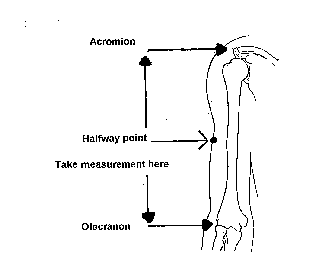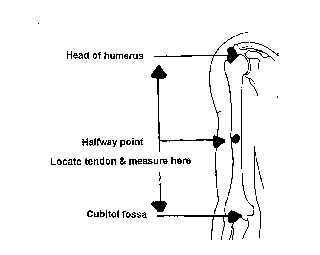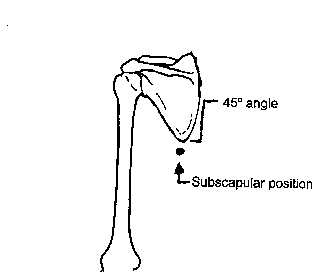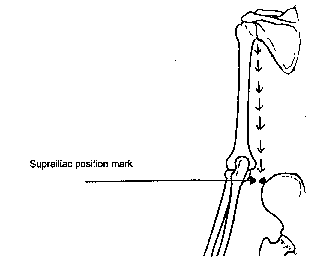start
page |
register
| log-in | software
Standard operating procedure
Anthropometric measures No: 007D
1. Introduction
Anthropometric measurements are widely used to predict body
density or fat content. A variety of different procedures can
be done. For this project, the techniques measured will be waist/hip
ratio and skinfold thickness. The subject may experience a slight
tightening pressure around the area where the skinfold thickness
is measured.
2. Responsibilities
Research nurses trained in the method are responsible for recording
all anthropometric measurements from all subjects.
3. Equipment
- Wessex-finger/joint
measure tape (for waist and hip measurements)
- Wooden
metre rule (for calibration purposes)
- Marker
pen
- Holtain/Tanner-Whitehouse
skinfold caliper
4. Method
The Omron
HEM-705CP digital blood pressure (BP) monitor, which is currently
one of the only portable monitors which has been validated by
the British Hypertension Society, will be used in this study.
The BP
monitor should have the charged batteries already installed;
the guidelines for this procedure can be observed in the Omron
manual. Additional batteries should also be available to protect
against battery failure. The monitor should also be programmed
with the correct date & time and printer paper. Any alterations
required with the monitor's set up can be achieved by reading
the guidelines from the manufacturer.
 4.1
Waist circumference
4.1
Waist circumference
- Instruct
the subject to unclothe their waist and hips. They do not
necessarily need to undress, but can for example undo trousers
and drop them to the top of thighs or hoist skirts up.
- Instruct
the subject to stand with their feet pointing forwards and
approximately 25-30cm apart. Their weight should be evenly
distributed.
- Feel
for the subject's lower rib margin and make a mark (with the
marker pen) at the exact level of the lowest rib margin.
- Palpate
the iliac crest in the midaxillary line and make a mark on
the skin surface.
- Measure
the distance between the two marks (rib cage and iliac crest)
and make a distinct mark between them. Ensure that this mark
is easily distinguished from the other two.
- Ensure
that you make the marks on both sides of the body, this improves
the reproducibility of the measurement.
- Instruct
the subject to breathe out gently whilst the measurement is
taken.
- Apply
the Wessex tape horizontally around the subject's body, line
the tape over the two middle marks and ensure that it is sitting
evenly (not tilted up on one side). Slot the end of the tape
in its designated hold. Tighten/loosen the tape so that it
is sits comfortably around the subject's body. The tape's
have an inbuilt tensioning device, so no further adjustment
needs to be applied after the tape has been correctly positioned.
- Record
each measurement in centimetres and document each, in the
subjects case report file. Take two independent measurements
on each subject to ensure reproducibility. Both measurements
should not differ by more than 0.2cm.
4.2
Hip circumference
- Following
on from the waist circumference, ensure the subject remains
in the same position and breathing out gently.
- With
the Wessex tape measure the point yielding the maximum circumference.
As before the tape should sit horizontally around the body,
without a tilt.
- Record
the measurement in centimetres in the subject's case report
file. Take two measurements on each subject.
- The
subject's part in the procedure is now complete.
4.3
Calculation of waist/hip ratio
For example:-
Waist
circumference = 25cm
Hip circumference = 34cm
Ratio calculation
(example) = 25 / 34 = 0.735
Upper threshold
range = Women = 0.85 Men = 0.95
4.4
Skinfold thickness
The caliper
is designed to scientifically estimate the amount of fat a body
possesses. It can be expressed either as a percentage of total
body weight or actual fat weight.
Record all
skinfold measurements in duplicate, this means that the complete
measurement is repeated twice, including picking up the skinfold.
This will greatly improve the reproducibility of the results
obtained. When measuring skin folds it is important to note
that you are not pinching the fat, but that you are gathering
a fold of tissue between your fingers to be measured.
When picking
up skin folds do not pick up the skin fold horizontally, using
your middle finger and thumb sweep up the fold of tissue.
Triceps
- Use the
left arm to record all triceps skinfold measurements.
- Explain
the procedure to the subject and show the subject the calipers.
Demonstrate how much pressure is exerted by them on the back
of the subject's hand.
- Instruct
the subject to remove clothing covering their left arm. The
subject may either stand or sit down for this procedure. f
- Stand
behind the subject, slightly to their left. Place your right
arm directly behind the subject's left arm.
- Instruct
the subject to relax their left arm by the side of their body;
it should be positioned so the palm is facing forward.
- With
the Wessex tape measure the distance between the postero-lateral
bony point of the acromion (bony part of the shoulder tip)
on the subject's shoulder to the olecranon (elbow tip). The
tape measure must not hang vertically, but must join the two
bony landmarks, with the right hand edge of the tape on the
centre of the upper border of the olecranon. Mark the halfway
point, on the right hand side of the tape, with the marker
point. The Tape is 1cm in diameter, allow for this by measuring
0.5cm inwards after the initial mark. Use the second mark
as the midway marker position. See figure 1 for more details.
figure
1

- With
your left hand, sweep up a vertical skinfold of about ½" from
just above the marked point. Ensure the skinfold is free.
- With
your right hand, hold the calipers horizontally behind the
subject's arm. Apply the jaws of the calipers so they sit
either side of the exact marked point. Slowly and gently release
the caliper handle and remove your left arm off the subject's
arm. The arm should remain relaxed and poised by the subject's
side.
- The caliper
needle should initially fall quickly and then gradually come
to rest. Take the reading as soon as the needle has stabilised
and stopped moving.
- Record
the measurement in millimetres to the nearest 0.2 division.
Ensure that you read the measurement in the correct direction
- CLOCKWISE
- After
the reading has been recorded, release the calipers.
Biceps
- Still
with the left arm, find the head of the humerus at the subject's
shoulder. Place the Wessex tape at this point and run it down
by the anterior aspect of the arm to the midpoint between
the two epicondyles of the humerus in the cubital fossa. Locate
the tendon and place the right hand side of the tape against
the tendon. See figure 2 for more details.
figure
2

- Mark
the halfway point, on the right hand side of the tape, with
the marker point. The Tape is 1cm in diameter, allow for this
by measuring 0.5cm inwards after the initial mark.
- Sweep
up a ½" skinfold above the marked point. Ensure the skinfold
is free.
- With
your right hand, hold the calipers horizontally and apply
the jaws of the calipers so they sit either side of the exact
marked point. Slowly and gently release the caliper handle
and remove your left arm off the subject's arm.
- As before,
record the measurement in millimetres to the nearest 0.2 division.
Ensure that you read the measurement in the correct direction
- CLOCKWISE.
- After
the reading has been recorded, release the calipers.
Subscapular
- Instruct
the subject to remove any upper body clothes (ladies can keep
their bras on for this procedure). The subscapular lies below
the lowest point of the scapula.
- Stand
behind the subject and locate the left scapula of your subject.
- The scapula
border nearest the spine runs downward and outward and then
forms an angle of about 45°. Mark immediately below this
point with a marker pen. You may find it easier to mark the
45° angle as an addition marker to aid in marking the
correct position for the measurement.
- The subscapular
measurement should be taken immediately below the 45°
angle with the marked point in the centre of the skinfold.
See figure 3 for more details.
figure
3

- The skinfold
should be picked up in the sloping line. A skinfold of approximately
½" should be measured.
- Use your
right hand to hold the calipers horizontally and apply the
jaws of the calipers so they sit either side of the exact
marked point. Slowly and gently release the caliper handle
and remove your left arm off the subject's arm.
- As before,
record the measurement in millimetres to the nearest 0.2 division.
Ensure that you read the measurement in the correct direction
- CLOCKWISE.
- After
the reading has been recorded, release the calipers.
Suprailiac
- Instruct
the subject to unclothe their waist and hips. They do not
necessarily need to undress, but can for example undo trousers
and drop them to the top of thighs or hoist skirts up.
- Locate
the subject's hip-bone, this lies directly in line with their
armpit.
- The suprailiac
position mark, should be made just above the hip-bone and
in line with the armpit. See figure 4 for more detail.
figure
4

- UNLIKE
the other skinfolds, the ½ " suprailiac skinfold should be
picked up VERTICALLY and NOT HORIZONTALLY. It should
still be lifted with a sweeping motion.
- Position
the middle finger and thumb in a horizontal line, either side
of the mark, sweep the skin together and pick it up vertically.
- As before,
record the measurement in millimetres to the nearest 0.2 division.
Ensure that you read the measurement in the correct direction
- CLOCKWISE.
- After
the reading has been recorded, release the calipers.
5.
Additional Information
- To ensure
the reproducibility of antropometric readings it is crucial
to maintain the standards laid down in the anthropometric
standard operating procedure document.
- Calibrate
the tension of the Wessex tape measure using the wooden ruler,
on a weekly basis and record the results in the calibration
book.
- Each
Wessex tape measure has a pre-determined lifespan of about
600 subject measurements, it is therefore vital that a log
is kept of each tape's usage. Over-usage could give rise to
poor measurements. If a tape does not meet the calibration
requirements it will no longer be used.
6.
Reference Documents
1. O`Brien
E.T et al, (1995), ABC of Hypertension, BMJ Publishing group,
London, 1-34
2.
Measuring obesity - classification and description of anthropometric
data, WHO report - consultation on the epidemiology of obesity.
Warsaw 21-23 Oct 1987. .

